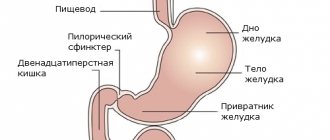Women who really want to become mothers take their health seriously. Having some chronic diseases or a tendency to them, they often wonder whether this will affect a future pregnancy. So it is with erosion. The prevailing opinion that nulliparous women should not cauterize erosion worries women. How will this disease affect pregnancy and the fetus? And in general, is it possible to get pregnant with such a female ailment? Let's figure it out.
Preparing for pregnancy after erosion treatment
At the moment, there are no specific methods for preparing a woman for conception after cauterization of erosion. The main actions are aimed at preventing the open wound from becoming infected after treatment and not causing a relapse of the disease.
Healing of the wound surface after treatment occurs within several weeks. However, complete restoration of a woman’s body, especially her reproductive system, can take quite a long time. The most important thing in this case: self-control and compliance with all the rules of the recovery period, which the doctor will tell the woman about.
The main recommendations for girls planning pregnancy after surgical treatment of erosion are:
- Sexual rest for 1-2 months after cauterization ensures faster healing and prevents infectious agents from entering the wound surface;
- Do not douche with aggressive solutions containing alcohol, iodine or manganese;
- It is necessary to use restorative agents prescribed by a doctor: vaginal tablets or suppositories;
- Until the doctor allows preparation for pregnancy, use barrier methods of contraception;
- Do not use any alternative treatment methods on your own without consulting a gynecologist.
The healing and recovery process depends on the size of the pathological lesion and the treatment method used. There are no specific rules on this matter, since everything depends on individual characteristics.
There are some recommendations on the timing of possible pregnancy after treatment of erosion:
First.
For small erosive lesions, the method of point cauterization is used. In this case, healing, regardless of the method of therapy, takes no more than 2 weeks, and pregnancy can begin to be planned after 3 months.
Second.
If the erosion was in the area of the external pharynx and had a more impressive size, then removal of the pathological focus can lead to problems with miscarriage. Therefore, before conception, it is necessary to wait until the wound has completely healed, which occurs on average after six months.
Third.
Large or multiple erosions are usually removed by conization of the cervix. In this case, recovery takes quite a long time, within a year. Also, after this method of treatment, gynecologists often do not advise independent childbirth, but recommend a cesarean section.
The main advice regarding possible pregnancy planning is to follow all recommendations of your doctor.
It is necessary to observe all precautions and undergo the necessary examinations in the process of restoring the body.
Share this post
▲ error: Who's here?
True erosion: tactics when planning pregnancy
True erosion is an ulcer that forms under the following conditions:
- Inflammation,
- Burn,
- Consequences of radiation therapy,
- Cervical cancer,
- Syphilis.
Against the background of these pathologies, pregnancy is possible in the presence of ovulation. But its course may be accompanied by complications. Any inflammation is a risk of an ascending infection, which in the first trimester can penetrate the uterine cavity. During this period, the placenta has not yet formed, which plays the role of a filter and is able to protect the fetus. The embryo itself is in the formative stage, so any infection leads to the development of congenital defects, which are often incompatible with life. A burn to the cervix or a radiation ulcer can become the basis for an infection that will negatively affect the course of pregnancy.
Syphilis is also dangerous for a child. But at the present stage of diagnosis, its advanced forms are extremely rare. Typically, all infected patients are quickly identified and treated.
Large erosion is dangerous during childbirth. Inflamed tissues are loose and easily injured. Therefore, when a child passes through the birth canal, there is a risk of additional injury. Cervical rupture and massive bleeding may occur.
All women with true erosion should undergo treatment. First, the etiological factor must be eliminated. If it is an infection, then the vagina is sanitized with appropriate medications. For radiation erosion, an ointment with dimexide is used, which is injected into the vagina under a controlled antibacterial environment.
Cancer erosion affects the general condition of a woman and, as it progresses, can lead to exhaustion and impossibility of conception. Therefore, treatment is carried out depending on the severity of the pathology. Cervical dysplasia is considered a precancerous disease, so its treatment is mandatory.
Cervical dysplasia, if not properly treated, can develop into a malignant formation.
How long after cauterization of erosion can one become pregnant?
There is no clear answer to this question. Each body is individual and reacts differently to outside interference. Talk to your doctor about when you can become pregnant after treatment.
In most cases, after the defect is cauterized with a laser, conception is planned within 2 months. You must have your scheduled period.
But if the lesions were removed chemically, it does not exclude the possibility of relapse, since it is not considered 100% reliable. It is advisable to wait about six months before pregnancy. It is during this period that the mucosal membranes will completely heal.
When cauterized with electric current, it should take approximately 45 days for complete healing. During this time, it is advisable to abstain from sexual intercourse. That is why they try not to prescribe diathermocoagulation to women of reproductive age. Electric current almost always causes the formation of scar tissue, so you will have to give birth not on your own, but by cesarean section.
After treatment with radio waves, you can get pregnant within a month.
After cryotherapy, you need to wait six months for the epithelium to recover completely. It is better to avoid sexual relations until the next month.
Expert commentary in this video:
https://youtube.com/watch?v=0UGhEG1Rtdg
How long after treatment and cauterization is it better to get pregnant?
Certain treatment methods are not recommended if the patient is planning a pregnancy in the near future.
Some methods promote the formation of scar tissue in the cervical canal area. This leads to miscarriage, and during childbirth - to rupture and large-scale blood loss.
This refers to the diathermocoagulation method - strong heating of the affected area with an electric current.
The result is a burn, and, as a consequence, a scar. After such treatment, it is better to abstain from conceiving for at least two months (before this, you must undergo an examination with a colposcope).
Doctors say that the danger of miscarriage accompanies a woman after diathermocoagulation for about five years. However, this method of treatment is outdated ; more modern and safe methods are now used.
They, like diathermocoagulation, are based on the removal or destruction of cells in the ectopic area, but differ in the methods of influence:
- Cryodestruction is the effect of liquid nitrogen on the altered area, which freezes it.
Cryodestruction does not cause scar tissue, but several such procedures will be required to heal the eroded surface.
Healing will occur no earlier than in one and a half to two months.
Cryotherapy is not suitable for patients with HPV (human papillomavirus), as it does not penetrate very deeply.
- Laser treatment is the coagulation of modified cervical canal cells with a laser beam.
The ectopic area “resolves” without scar formation. Gynecologists believe that you can plan to conceive within a month after the procedure.
Laser treatment has some disadvantages: it is expensive and is not used everywhere.
- Radio wave method - it does not provoke the formation of scar tissue at the site of destruction and eliminates contact with the affected surface during treatment.
This is the most modern and effective method and has an antimicrobial effect. Suitable for treatment immediately before the expected conception (but taking into account the sexual rest prescribed by the doctor for a certain time after the procedure).
After destruction by any of the methods, discharge of ichor from the vagina is observed for several days.
At this time, sexual rest is recommended, otherwise you can get an infection.
Treatment methods for cervical erosion:
Let's tell you more about cervical erosion:
- methods of cauterization;
- how the procedure works;
- does it hurt;
- how to prepare for it;
- what complications may arise after it;
- features of discharge after.
Diagnostics
In order to confirm the diagnosis, the doctor, in addition to questioning, collecting complaints and anamnesis, and an extended gynecological examination, prescribes:
- Colposcopy. One of the most accurate research methods, allowing you to study the condition of the mucous membrane and determine the boundaries of the lesion.
- Biopsies. It involves pinching off a piece of cervical tissue for further histology.
- Collecting a smear. Specific diagnostics to identify atypical cells.
- Colpomicroscopy. With this study, you can study the mucous membrane under magnification up to 300 times.
Only after a thorough diagnosis and the exclusion of malignant degeneration is therapy prescribed.
What diseases are united by the term “erosion”
Diseases are often asymptomatic, detected only during colposcopy - examination of the vaginal area and cervix using a colposcope. During diagnosis, several pathologies may be detected:
- True erosion
is a disease in which a reddish ulcer forms on the neck, which can bleed. The reasons for its appearance are different - mechanical damage, corrosive discharge during sexually transmitted infections, decreased immunity, in which the cervical region is attacked by its own microorganisms.
- Pseudo-erosion
, in which a cylindrical epithelium appears on the neck instead of a multilayer epithelium, which should not be there. Pseudo-erosion can increase in size and bleed. Such a lesion can be congenital, caused by improper formation of cervical tissue, and also occurs against the background of inflammation, sexually transmitted infections and hormonal imbalances. Without treatment it can develop into cancer.
- Ectropion is an “eversion” of the cervical tissues. In nulliparous women, it is caused by unsuccessful opening of the cervix during late-term abortion or other medical procedures. Requires treatment to restore the physical condition of the cervical tissues.
- Dysplasia is an erosion containing improperly developed and deformed cells. The risk of developing cancer with this disease is quite high. The cause of the disease is infection with the sexually transmitted papilloma virus. It can occur at any age, regardless of childbirth.
How is this pathology treated?
The genitals of a pregnant woman are examined by a gynecologist upon registration and in the future if she voices complaints of discomfort - abdominal pain in the lower part, discharge, etc.
If a visual examination reveals erosion, then a cytostudy is required to identify atypical cells - the appearance of these cells signals a possible degeneration of the disease into a malignant form.
They also determine the presence of antibodies to sexually transmitted infections of various etiologies, the papilloma virus, and a colposcopy procedure may be required.
If the lesion is large, then treatment begins. Drugs are prescribed that stimulate mucosal regeneration - during pregnancy, preference is given to topical agents in the form of suppositories and vaginal tablets.
Since cauterization or other surgical measures can easily cause a breakdown, causing impulsive contractions of the uterus, which is especially dangerous in the early stages, they try to avoid these actions. But sometimes the doctor still has to carry out manipulations that promote the healing of the cervical defect and do not cause scarring of the birth canal.
A drug with antiseptic properties is applied to injured mucous membranes. A crust forms on the surface of the ulcerative defect, which then peels off on its own. It is impossible to completely cure large erosive lesions in this way, but such an effect makes childbirth easier in the future and prepares the birth canal so that the baby is born without surgical intervention.
Treatment when planning pregnancy
The ideal option is to eliminate the erosive defect before pregnancy.
Modern young women understand how important it is to remove any source of danger from the body, find out their immune status in advance, and treat chronic diseases. If a problem is discovered, very often the doctor decides to eliminate it
There is no need to be afraid of the procedure. Previously, only one method was used - cryotherapy (cauterization with liquid nitrogen).
Nowadays, gentle methods have appeared that do not cause scar formation. When you can get pregnant after treatment and cauterization of erosion is discussed individually in each case.
- The erosive defect is cauterized with laser beams. This operation does not stimulate the scar-adhesive process, pathogenic bacteria are simultaneously destroyed (if present), and bleeding does not occur. Conception can be planned 1-2 months after the procedure, as soon as the scheduled menstruation has passed. Treatment does not have any effect on childbirth.
- For multiple small lesions, chemical cauterization is performed. The method is considered not very reliable - it does not exclude the possibility of relapse. It is advisable to plan a pregnancy no earlier than after 4-5 months - this period is necessary for the mucous membranes to finally heal.
- Diathermocoagulation - cauterization with high-frequency currents - is tried not to be used for the treatment of women of reproductive age. But in some cases, such a therapeutic method is considered the only possible one. In this case, complete sexual rest is recommended until complete healing (30-45 days), so you can think about planning no earlier than 2 months after the manipulation. In addition, when the procedure is performed using this method, the patient is always warned that - most likely - she will have to give birth by cesarean section. Electric current causes scar formation on the cervix.
- The most modern and gentle method is radio wave vaporization. The erosive defect is eliminated, the mucous membrane is regenerated within a month and you can immediately think about conception.
- But cryotherapy has not yet been forgotten. In small towns this is often the only way. This procedure is the lowest in cost and the most popular in terms of prevalence. After manipulation, it is advisable to postpone pregnancy for at least 4-5 months so that the epithelium is fully restored. Also, a woman should avoid sexual intercourse until her next menstrual period.
You should not worry or refuse treatment if the gynecologist recommends treatment before planning.
To the question whether it is possible or not to get pregnant after cauterization of erosion, the answer is a clear “YES!” However, when preparing for childbirth, a woman must be warned about treatment for this disease. This will help you optimally prepare for childbirth.
Pseudo-erosion in nulliparous women
Not every cervical pathology is called erosion. In young women, pseudo-erosion more often occurs - a change in the epithelium near the external pharynx similar to the internal lining of the cervical canal. On the outside there are cylindrical cells, which should not be on the vaginal part of the cervix. Such defects do not affect the onset of pregnancy. But a thorough diagnosis is necessary to exclude cellular atypia.
Further tactics depend on additional reasons:
- If pseudo-erosion is uncomplicated, but there are hormonal changes, you can limit yourself to their correction. In this case, local treatment is not carried out. Epithelization of the cervix can occur while taking combined oral contraceptives. They will correct the functioning of the ovaries and establish the necessary cycle of hormone release. Pregnancy in this case can occur immediately after discontinuation of the drug (within 1-3 months). This is called the “rebound effect”, when the follicle actively matures in the rested ovaries and timely ovulation occurs,
- Uncomplicated ectopia, in which disturbances in the ratio of stroma and epithelium are histologically detected, requires appropriate tactics. If a woman is planning a pregnancy, it is recommended to undergo laser or radio wave treatment. After cauterization of cervical erosion using these methods, scars do not form, so the cervix opens without problems at the time of childbirth. This procedure also does not interfere with pregnancy. After healing, the condition of the cervix remains normal, no severe complications arise in the form of sclerosis, retention cysts, endometriosis or inflammatory reactions,
- Complicated and recurrent erosion must be treated in several stages. First, the vagina is sanitized. The choice of drug depends on the type of pathogen - bacterial infection, virus or fungus. The second stage is the direct treatment of erosion. The final stage is correction of vaginal microbiocenosis and stimulation of reparative processes.
With uncomplicated ectopia with hormonal problems, the squamous stratified epithelium of the cervix can be restored by taking combined oral contraceptives.
To make conceiving a child possible after treatment of complicated erosion, only methods that do not lead to scarring are used.:
- Cryodestruction - the use of liquid nitrogen to eliminate a defect in the mucous membrane,
- Cauterization with Solkovagin. Preference is given to this method in the presence of a transformation zone with involved nabothian glands,
- Electrocryotherapy is carried out in one step: first, electric cauterization is carried out, and then treatment with liquid nitrogen. Electrotherapy is performed superficially so that trauma to the neck is minimal. This method of therapy is necessary in the presence of cystically dilated glands. In other situations, electrocoagulation is not used, since after it there is a high probability of scarring.
Diathermocoagulation is not recommended for women of reproductive age. It leads to serious complications:
- Bleeding,
- Menstrual irregularities,
- Endometriosis,
- Sclerosis of the cervical canal,
- Cervical cysts.
Uncomplicated erosion cannot prevent conception. A small defect of the cervix before the first pregnancy, which was identified at the time of registration, cannot be treated. During periodic examinations, the gynecologist monitors the condition of the organ. If the defect is stable, no further changes occur in it, and cytological analysis does not reveal atypical cells, then the pathology does not pose a serious danger.
Modern methods of therapy gently relieve erosion, even if it is large. These methods include:
- Radio wave therapy,
- Laser coagulation.
Radiotherapy is the evaporation of pathological foci using high-frequency radio waves. Healthy areas of the epithelium are not damaged, there is no bleeding, and no scars are formed. Recovery after the procedure is quick. The absence of scars does not prevent the cervix from opening during childbirth. This method very rarely gives complications.
Laser coagulation is optimal for the treatment of erosion in women who are just planning motherhood. The defect evaporates without bleeding or damaging healthy tissue. The method also does not leave scars.
Laser coagulation of cervical erosion is considered one of the most effective treatment methods for nulliparous women.
Prevention before pregnancy
One of the stages of conception planning is an examination by a gynecologist. If problems are identified, including erosion, treatment is prescribed. If the lesions are not extensive, drug therapy is carried out. In case of severe damage to the mucosa, surgical methods are indicated.
Only after 2–3 months (with a regular cycle) can you plan to conceive. To prevent the recurrence of erosion it is recommended:
- avoid stress and overwork;
- give up bad habits (smoking, alcohol abuse);
- treat concomitant diseases;
- exclude frequent changes of sexual partners;
- wear quality underwear;
- be examined every six months.
Why is it dangerous?
Doctors often use the word “erosion” to mean pseudo-erosion, or ectopia. After all, true erosion is very rare. Don't worry if you want to get pregnant with this cervical disease.
As a rule, erosion is fertile ground for the reproduction and development of various viruses that are sexually transmitted. It, according to doctors, can be the basis for malignant neoplasms. It is quite difficult to diagnose the causes of its appearance. One can only speculate on some of the reasons for its occurrence. These include early onset of intimate relationships, hormonal imbalances, decreased immunity, multiple abortions, inflammation, vaginal dysbiosis and sexually transmitted infections. Typically, the course of treatment for erosion begins with anti-inflammatory therapy. This is done to eliminate the infectious lesion.
Will it be possible to conceive with this disease?
This pathology does not affect the ability to conceive in any way.
If the hormonal level and patency of the fallopian tubes remain normal in the presence of erosion and there are no other diseases that can prevent pregnancy, then conception is quite possible with unprotected coitus.
There can be difficulties with pregnancy, but they arise not because of the pathology itself, but in connection with the diseases or conditions that caused it. For example, erosion may be the result of a hormonal imbalance that prevents conception.
After diagnosis, you need to undergo a detailed examination to identify the causes of cervical erosion.
Timely prescribed and administered antibacterial or hormonal therapy can cope with problems of conception. This will make it possible for the desired pregnancy to occur.
Therefore, if a woman is planning a pregnancy and during this period finds out that she has erosion, she should not give up her intentions.
Ectopia itself will not prevent you from getting pregnant. However, it is better to find out why it appeared; perhaps the reasons for the difficulties in conceiving lie precisely here.
Ectopia does not require treatment if it is not complicated by inflammation or other diseases. However, treatment before pregnancy is supported by the fact that erosion is an entry point for infection, which is very dangerous for the fetus.
If treatment is still necessary, then for those planning to give birth soon, some methods are strictly contraindicated. Ectopia can also be an age-related feature that will disappear only after a few years.
Often this condition disappears without a trace after childbirth. Therefore, if such a diagnosis is made, you need to be thoroughly examined and discuss with your doctor the need for therapy, if necessary.
Erosion and ectopia of the cervix - what is it and why does it occur:
Can erosion appear again after childbirth?
Erosion will manifest itself again if the causes of its occurrence are not eliminated. Therefore, before treatment, a woman is examined for sexually transmitted infections, thrush, and hormonal problems. Identified pathologies are eliminated.
Cervical lesions may reappear after a difficult birth. In this case, repeated treatment is carried out. At the same time, other consequences are eliminated - traces of tears, sutures, narrowing or widening of the cervical canal.
Therefore, erosion can occur in a woman or girl at any age. The disease does not indicate the presence of sexually transmitted infections or other pathologies, since it may even be congenital. During pregnancy, the pathological focus cannot be touched - this can only be done after childbirth. Modern methods of treating erosion do not leave marks and do not affect labor.
The best option is to prevent the development of the disease by regularly visiting a doctor, correcting hormonal imbalances, and eliminating fungal, viral, and microbial infections.
Moxibustion cause of infertility
It is not always possible for a nulliparous woman to be cured in a safe way - cauterization with liquid nitrogen. This method is used only when the erosive lesions have a small diameter. If the damage is total, you have to resort to other methods
That is why it is so important to undergo a preventive examination with a gynecologist at least 2 times a year, because timely detection of pathology allows for its treatment in the safest and least traumatic ways
It is not always possible to get pregnant with cervical erosion after therapy. This is due to the fact that after the procedure, a scar formation forms on the soft tissue, which not only interferes with the fertilization process, but also provokes early miscarriage. If extensive pathology with the presence of concomitant diseases is detected, it can be quite problematic to carry out the cauterization procedure without complications. Cauterization of an advanced stage leads to the formation of numerous scars, as a result of which a woman may remain infertile.
When can you plan a pregnancy?
You can plan a pregnancy after successful treatment. It is possible to get pregnant in the next menstrual cycle, but doctors recommend first being examined 2-3 months after therapy. This is necessary to ensure that erosion has completely disappeared.
https://www.youtube.com/watch?v=0UGhEG1Rtdg
The rate of tissue healing after the procedure depends on the treatment method and the individual characteristics of the woman’s body. It is important to follow your doctor's recommendations to speed up the process of tissue regeneration. Young girls are recommended to remove erosion using a laser, since this method is the safest, does not leave scars on the cervix and does not affect reproductive function.
Methods for treating erosion
It is quite possible to cure erosion completely. Now for this there is not only colposcopy, but also other methods that do not cause bleeding. This disease is treated quickly and in most cases painlessly. But you need to contact a specialist in time, even if the erosion is minor.
The defect is eliminated in various ways. There is no anesthesia for them, since the cervical canal has practically no pain receptors.
Each of these methods is considered virtually painless:
- Cauterization is carried out with a mixture of concentrated acids. The consequences after such an intervention are minimal. Healing occurs within 3 weeks.
- DEK cauterization is done using electrodes. Columnar epithelial cells are removed. Subsequently, brown or bloody discharge may be observed after the scab is rejected.
- Cryodestruction is the freezing of erosion using liquid nitrogen. This therapy is effective, but is fraught with relapses.
- Laser is considered the most modern and painless. There are no complications. But heavy next periods are possible.
- A radio wave resembles a laser. Foreign cells are removed with virtually no damage. Heals within 3 weeks.
Pharmacological treatment
Drug therapy is relevant for small lesions. It is used if the erosion is shallow and the woman has not yet given birth or is pregnant. Prescribed drugs are Fluomizin, Chlorophyllipt, Kameton aerosol, Hexoral aerosol, Hexicon suppositories and others.
Subsequently, correction of hormonal problems and immune status is mandatory. However, doctors try to first eliminate the cause of the damage, and only then carry out treatment. Therefore, it is imperative to get tested for infectious diseases.
Surgical methods
This method of treatment is the most traumatic. The specialist performs local surgery. If you plan to become pregnant in the future, it is better not to use it. Moreover, there are a lot of alternative methods that do not leave adhesions. But if the erosion cannot be cauterized, since the damage occupies almost the entire surface, there is no other way to cure it.
Helper Methods
The auxiliary technique consists of traditional medicine. Calendula tincture and sea buckthorn oil are used. The first is used to make baths, and the second is used to soak tampons.
It is not recommended to do this without consulting a doctor, as it can cause unpredictable reactions.
Please note that gynecology is a sensitive area that requires caution. Is it worth doing such manipulations, in what form and for how long, it is better to ask your doctor
Should cauterization be performed before pregnancy?
Is it worth cauterizing erosion before pregnancy? It is difficult to give a definite answer to this question. On the one hand, the disease negatively affects conception, gestation and birth of a baby. However, after any method of cauterization - cryodestruction, radio wave treatment, laser vaporization, electrocoagulation, chemical coagulation, a rather dense scar may appear on the surface of the organ.
As a result, the diameter of the cervix decreases and its patency decreases. How to get pregnant in this case? Usually it is not possible to conceive a child on your own, so women decide on IVF - artificial insemination.
Possible complications
A woman can conceive a child against the background of unexamined erosion, but the risk of complications is very high. Problems can arise at all stages of pregnancy - from the first days after fertilization to childbirth. You should be wary of:
- frozen pregnancy;
- early spontaneous abortion;
- the occurrence of isthmic-cervical insufficiency;
- intrauterine infection of the fetus;
- premature birth;
- injuries to the birth canal in a woman;
- rapid transition of erosion to cervical cancer.
A pregnant woman's immune defense always decreases, therefore, with initial dysplasia before conception, the risk of malignancy increases: a situation is possible when planning and examination are not carried out, a pregnant woman has a large erosion on the cervix, she carries and gives birth to a child, and after childbirth the doctor discovers malignant degeneration of the cells in the area of the cervical canal. It is impossible to predict how long after cervical problems are detected, life-threatening situations will arise.
How dangerous is cervical erosion?
The cervix is an internal organ that connects the uterus and vagina. A surface defect such as an ulcer, in which the normal epithelium changes to a columnar epithelium, is called erosion.
There are two types of such damage:
- true;
- ectopia.
In the first case, a noticeable red spot appears on the surface of the pale pink organ. The surface is broken and almost always begins to bleed. Due to changes in the usual normal environment, bacterial infections begin to develop.
Doctors often cite unstable hormonal levels, various infections, as well as rough sexual intercourse as the reasons for the appearance of this disease.
With ectopia, the flat cells of the cervical epithelium change to cylindrical ones. It is this type that has the risk of developing into oncology, although the causes of defects and symptoms are the same as those of the previous variety. The probability of developing a malignant disease is about 30%. Much depends on the person’s living conditions and other objective factors.
In most cases, erosion practically does not manifest itself at all.
In some clinical cases, the following symptoms develop:
- discharge with blood, absolutely independent of the menstrual cycle, appears after physical activity or sexual intercourse;
- discharge of mucus with pus;
- pain during penetration of a sexual partner;
- pulling and unpleasant sensations during menstruation, but not in the stomach, namely in the genital tract.
Due to the fact that the pathology is clearly visible in the main cavity of the organ, it is easy to diagnose. It is enough for the doctor to examine the patient in a gynecological chair. To confirm the diagnosis, various smears and tests are done, which cause virtually no discomfort.
What is erosion?
Cervical erosion is a location of the epithelium that looks like a red spot around the opening of the canal. In other words, this is a pathological change in the lining of the uterus. This disease is quite common and in most cases is asymptomatic. Sometimes erosion is characterized by slight bleeding. As a rule, only a doctor can detect erosion in a woman during examination. Erosion occurs in half of nulliparous women.
Erosion does not require special efforts in treatment. But most methods of treating it, including cauterization, leave scars on the cervix. This, as a rule, threatens pregnant women with difficulty opening the uterus during childbirth. After all, it stretches and sometimes breaks. That is why getting rid of erosion for a nulliparous woman should be carried out using the most gentle methods that do not leave scars.
Treatment
To get rid of cervical pathology, a woman needs to undergo several studies and only after that the doctor will decide on the advisability of using one or another type of treatment.
The choice of therapeutic tactics is influenced by several factors: the cause of the development of the pathological process, the presence of infection, the features and main characteristics of erosion, and the like.
In modern medical practice, doctors use the following techniques to cure erosion and then get pregnant:
- local treatment with antibacterial agents. They allow you to get rid of infection, and thereby reduce the manifestations of erosion and promote healing;
- cauterization with chemicals (mixture of acids);
- laser destruction of the defect. The laser beam affects the affected tissue without subsequent scar formation;
- cryodestruction of erosive formation with liquid nitrogen;
- Diathermocoagulation is a cauterization technique using electric current. This method gives good results, but scarring may occur after it, and this is undesirable for those planning a pregnancy;
- excision of an erosive defect using radio waves, which has the working name “radio knife”;
- folk treatment, the effectiveness of which has not been fully proven. Therefore, practicing doctors treat it with caution, not believing that using traditional medicine recipes can eliminate the disease.
Symptoms and diagnosis
Difficulties in diagnosing erosion are caused by the absence of obvious symptoms of the disease. But if inflammation is added to the disorder, a woman who carefully monitors her condition will note:
- pain in the lower abdomen;
- discharge;
- discomfort during sexual intercourse.
The color of the discharge is not normally observed; it is transparent or slightly whitish. A change in color is always a sign of infection:
- thick brown discharge is characteristic of mechanical injuries of the vagina and cervix, inflammation of the endometrium due to expanding erosion;
- yellow discharge indicates an infectious complication of opportunistic flora (streptocci, staphylococci);
- thick white discharge is characteristic of a fungal infection (candidiasis, thrush).
To establish an accurate diagnosis, the doctor uses both visual examination and hardware diagnostics. This:
- interviewing the patient and collecting anamnesis;
- visual inspection of the cervix in the mirrors;
- examination using a colposcope (a device that combines a microscope and lighting);
- vaginal smear to determine vaginal microflora;
- material for histology;
- determination of the presence of sexually transmitted infections, human papillomavirus using a PCR reaction;
- general clinical urine analysis;
- biochemical and general clinical blood tests;
- blood for hormones;
- Ultrasound.
A smear examination will determine the composition of the vaginal microflora and the presence of pathogenic microorganisms. Examination of the cervix under a colposcope will determine the erosion and its area.
A blood test for hormones will reveal abnormalities and determine whether the malfunction is the cause of ectopia. If infections are detected, including genital infections, they are treated first.
What is the pathology itself?
The cervix is a gynecological organ that connects the vagina and uterus. When an ulcerative defect occurs on the surface of the cervix, the mucous epithelium is replaced by a cylindrical one, which covers the cervical canal.
Erosion can be divided into 2 types.
1 – true erosion. A red spot appears on the cervix, which stands out sharply against a pale pink background. The defect breaks the surface, resulting in an ulceration that can bleed. As a result, a favorable environment appears for the development of bacterial infection.
The causes of the pathology are:
- immature hormonal levels;
- gynecological diseases of infectious etiology;
- rough sexual intercourse.
2- ectopia. This is a condition in which the squamous cervical epithelium is replaced by columnar cells. The reasons for the appearance of the defect are the same as for true erosion, but the human papillomavirus is especially considered.
If the risk of erosion degeneration into an oncological process is quite low - 1/100 - then in the presence of a virus of this type, the probability of malignancy increases significantly and reaches 17-30%, depending on climatic, professional and social conditions.
A defect in the mucous membrane may not manifest itself in any way and can only be detected during a routine examination, but sometimes the following symptoms indicate it:
- bloody vaginal discharge not associated with the menstrual cycle and appearing after coitus or after physical activity;
- mucous discharge with purulent inclusions;
- painful penetration during coitus;
- pulling sensations in the genital tract during menstruation.
The pathology is easily diagnosed - the doctor sees it with the naked eye when he examines it on the chair with mirrors. To confirm the diagnosis and accurately describe the clinical picture, it is necessary to take material from the mucous membrane for analysis; colposcopy may be required.
Is it possible to get pregnant with cervical erosion?
As such, an erosive defect on the mucous membrane does not in any way interfere with the onset of conception; it does not affect the reproductive ability of the body. But when the problem turns out to be caused by a hormonal imbalance or appears after a sexually transmitted disease, then pregnancy may not occur.
During an acute infectious process, both the cervix and the canal are deformed, and adhesions can form in the fallopian tubes, through which the egg descends from the ovary to meet the sperm. The adhesive process complicates the possibility of pregnancy.
If conception has occurred and the fetus has implanted into the uterus, erosion may pose some threat to the course of the pregnancy.
Defects in the cervix increase the risk of activation of pathogenic flora.
You need to know that during childbirth, ruptures may form in places of erosion, and subsequently scars will form, which will negatively affect independent delivery the next time.
The task of how to get pregnant with cervical erosion is not difficult. However, women with a similar pathology require more attention during pregnancy. If the defects deepen, they are eliminated even before birth, although in most cases gynecologists take a wait-and-see approach.








